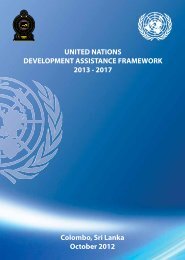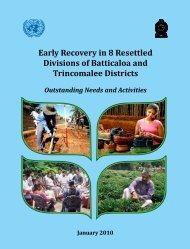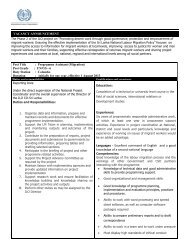Sri Lanka Human Development Report 2012.pdf
Sri Lanka Human Development Report 2012.pdf
Sri Lanka Human Development Report 2012.pdf
Create successful ePaper yourself
Turn your PDF publications into a flip-book with our unique Google optimized e-Paper software.
The poverty gap index, which measures the depth of<br />
poverty, has declined from 2006-2007 to 2009-2010,<br />
with significant reductions in Uva, Sabaragamuwa, the<br />
central provinces and the estate sector. This progress<br />
does not extend to the Eastern Province, indicating a<br />
marginal reduction in inequality. Compared to 2007,<br />
The increase in per capita GDP has improved the living<br />
conditions of poorer groups, translating into a lower<br />
poverty incidence. The most significant improvements are<br />
in regions that were the poorest in 2006-2007, including<br />
Uva, Sabaragamuwa and Central provinces, and in the<br />
estate sector. Overall, however, the poorest 20 percent<br />
Figure 2.9: GDP per Capita and Poverty Head Count Ratio by Province,<br />
2006-2007 to 2009-2010<br />
Sources: Department of Census and Statistics of <strong>Sri</strong> <strong>Lanka</strong> 2011c and 2011d, and Central Bank of<br />
<strong>Sri</strong> <strong>Lanka</strong> 2010.<br />
GDP per capita income increased in 2009 in all provinces<br />
(Figure 2.9). It was highest in the Western Province at<br />
Rs. 375,000, nearly twice the value of Rs. 213,000 for the<br />
North Western Province, the second highest.<br />
of the population in <strong>Sri</strong> <strong>Lanka</strong> received only 4.5 percent<br />
of total household income, while the richest 20 percent<br />
received 54.1 percent. Income inequality needs to be<br />
tackled for sustained human progress. 51<br />
28<br />
sri lanka <strong>Human</strong> <strong>Development</strong> report 2012






